Avoid your inquiry is delay response, please enter your WhatsApp/Skype along with the message, so we can contact you at the very first time.
We will reply you within 24 hours. If for urgent case, please add WhatsApp/WeChat: +8613791936882 ,. Or call +86-18678911083 directly.
Transporting flowers can be tricky. They’re delicate, and any rough handling can lead to damage. But with the right equipment, it doesn’t have to be hard.
The easiest way to transport flowers is using a flower trolley. Designed to keep flowers secure, it provides the stability needed to move them without damage.
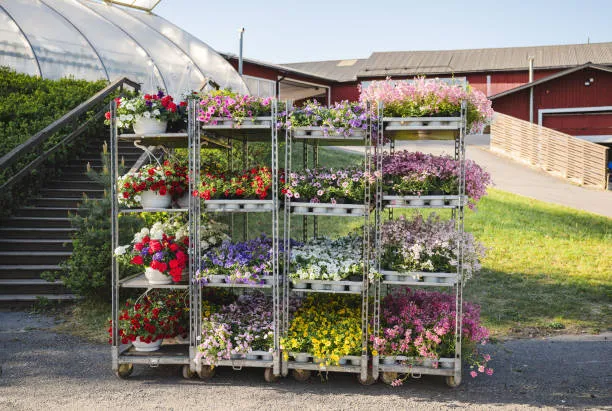
Transporting flowers safely
But what exactly makes a flower trolley the best option for transporting flowers? Let’s dive into the specifics of how to transfer fresh flowers and which methods work best.
Transferring fresh flowers isn’t as simple as just moving them from one place to another. It requires caution, especially if you want them to remain in top condition.
Fresh flowers should be transferred using secure, padded solutions like flower trolleys, which protect them from jostling and help maintain their fresh appearance.
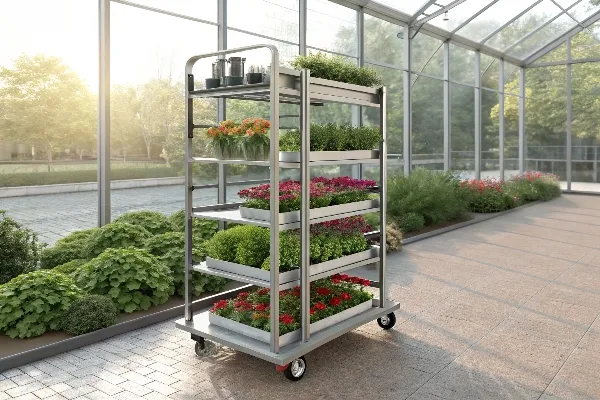
Transferring fresh flowers
Transferring fresh flowers can be a delicate task, especially when it comes to avoiding bruises or breakage. Flowers are often sensitive to temperature and motion, so it’s essential to ensure they are well-cushioned during transportation. Flower trolleys are the most efficient way to do this. These trolleys are specifically designed to secure flowers during transport, preventing them from falling or getting damaged. The key feature of these trolleys is their adjustable racks, which can hold flowers in place and minimize contact between them.
Using padded trolleys also helps in protecting fragile flowers like lilies or orchids, which are prone to bruising. The better the protection, the longer your flowers will remain fresh. For shops and businesses that need to transport flowers frequently, investing in flower trolleys makes it easier to move flowers from storage areas to display cases with minimal risk of damage.
Plants, just like flowers, need careful handling during transportation. Their roots and leaves can be easily damaged if not moved correctly.
The best way to transport plants is by using plant-specific trolleys, which provide proper support and ensure they stay upright, preventing any harm to their roots and stems.
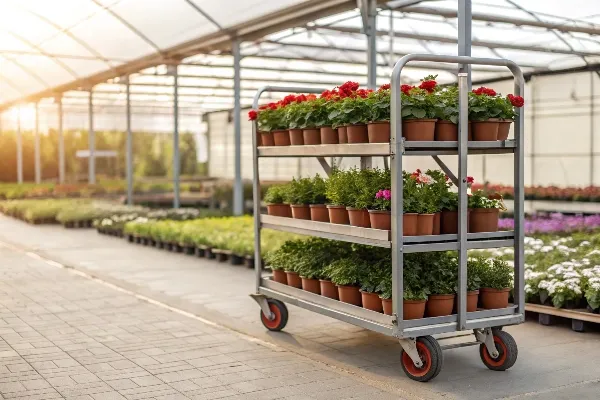
Plant transportation
Dive deeper Paragraph:
When it comes to transporting plants, there are a few considerations that go beyond simply moving them from one place to another. Plants, unlike flowers, have roots that need to be kept intact, and their leaves or stems can break easily if not supported properly. For transporting potted plants, trolleys with adjustable compartments can be a game-changer. These trolleys prevent the pots from shifting, reducing the risk of accidents.
A good plant trolley has a sturdy base and features that secure the plants. Some models even include features like padded trays or compartments, offering even better protection for fragile plants. Additionally, for larger plants or trees, trolleys with more substantial weight capacities and larger wheels are ideal. Larger wheels provide the stability necessary when moving larger pots and ensure that the plants remain upright without tipping over during transit.
For long-distance plant transportation, temperature control is another important factor. Using trolleys with built-in coolers or insulated covers can help ensure that the plants are transported in optimal conditions, keeping them safe from extreme temperatures that could cause damage.
Flower trolleys have become essential for anyone involved in the flower industry. They are designed to help transport flowers efficiently and safely.
Flower trolleys are specialized carts designed for transporting flowers. They are durable, customizable, and provide stability to prevent flowers from getting damaged during movement.
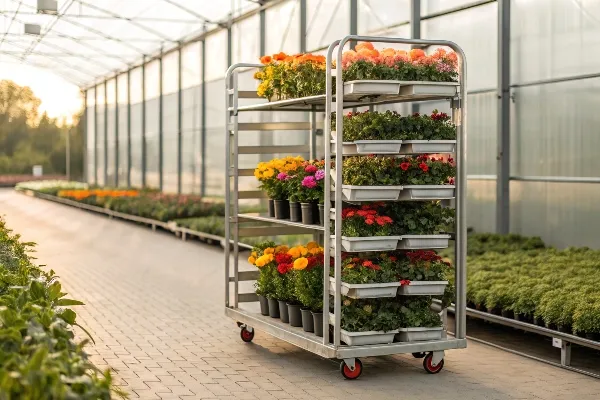
Flower trolleys for easy transport
Flower trolleys are an invaluable tool for florists, greenhouse operators, and anyone who needs to transport flowers regularly. These trolleys are designed with adjustable racks or shelves that can hold flowers securely, keeping them in place during movement. The design of the trolley often includes dividers or trays to keep individual stems from touching one another, which is important to prevent bruising or other damage.
The material used in making flower trolleys also plays a crucial role in their effectiveness. Most flower trolleys1 are made from durable metal or plastic, ensuring they can handle the weight of large flower shipments. They are also designed to be easy to maneuver, with smooth-rolling wheels that can handle different surfaces, whether in a warehouse, store, or greenhouse.
Flower trolleys are customizable, with options to adjust the height, number of shelves, and even color, so they can fit the unique needs of different flower shops or logistics companies. This customization allows businesses to create trolleys that are tailored to their specific storage and transport requirements, making the process more efficient.
You might wonder how much weight a flower trolley can bear. After all, when you’re transporting multiple flowers or large plants, weight capacity matters.
Flower trolleys typically handle weights between 100 kg to 300 kg, depending on the model. This range is suitable for transporting large quantities of flowers and plants.
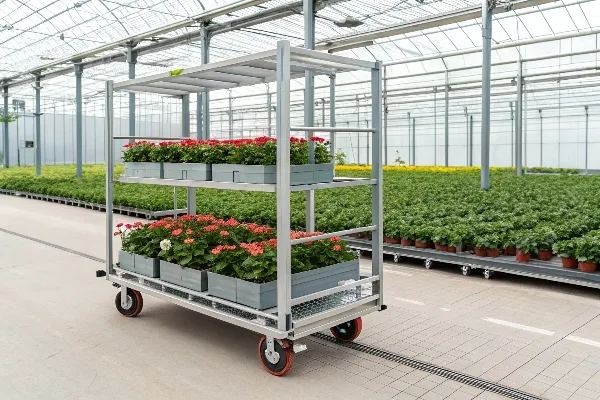
Flower trolley weight capacity
The weight capacity of a flower trolley depends largely on its design, material, and intended use. Most flower trolleys are built to support weights in the range of 100 to 300 kg, which is more than sufficient for most flower arrangements, bouquets, and potted plants. However, for larger operations or those that require moving large plants or multiple flower trays, some trolleys are designed to handle even heavier loads.
The material of the trolley affects its weight-bearing capabilities. For instance, trolleys with a steel frame tend to offer more weight support than those made from plastic or lighter materials. Additionally, trolleys with larger, reinforced wheels tend to distribute the weight more evenly, which helps prevent tipping and ensures a smoother transport process.
It’s important to keep in mind that the weight should be evenly distributed across the trolley to avoid overloading any single point. This will help maintain the trolley’s stability and prolong its lifespan. Also, checking the specifications for each model will give you a better idea of its exact weight capacity2 to ensure it meets your needs.
Flower trolleys offer an efficient and reliable solution for transporting flowers and plants. With adjustable features and various weight capacities, they make handling delicate products much easier.